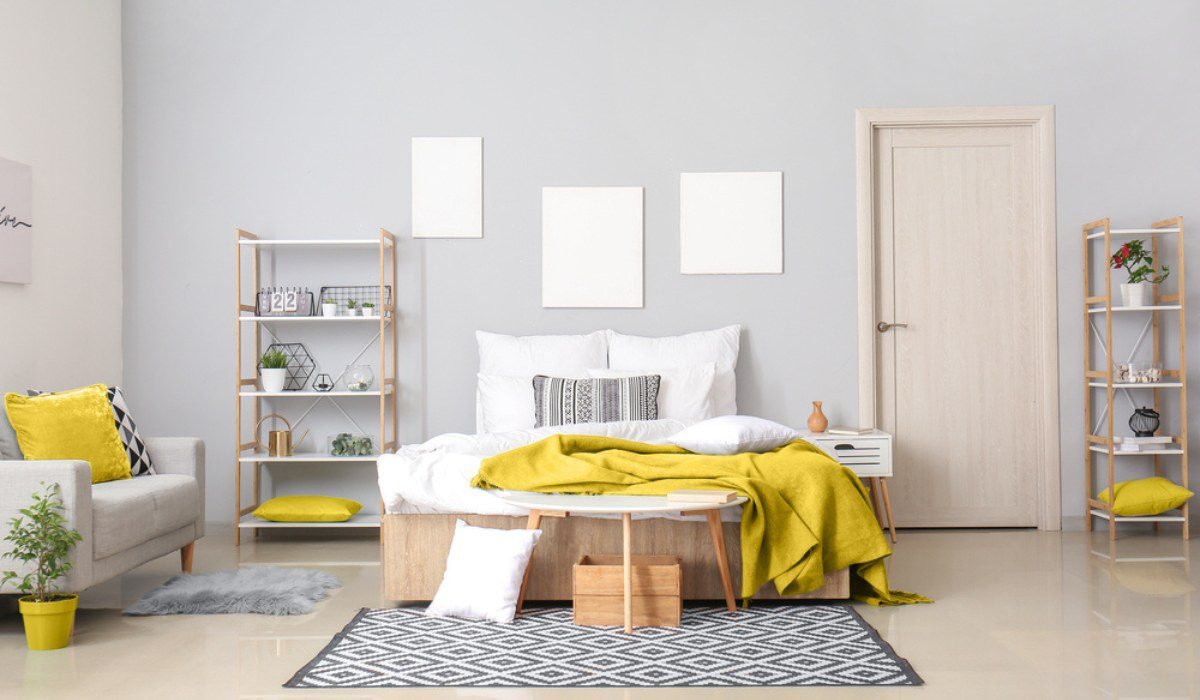Choosing the correct paint colour for a bedroom is an important choice since it has a big impact on the atmosphere and, in turn, the quality of sleep. The psychology of colour has a significant impact on how relaxed and happy one feels. This article discusses the significance of colour choice, the advantages of particular hues and offers a list of ten carefully chosen colours that are thought to encourage a peaceful and comfortable environment in the bedroom.
The colours that surround us have a significant effect on our feelings and general wellbeing. Paint colour selection is crucial in a place like the bedroom where rest and relaxation are top priorities. Relaxing hues help to foster a calm atmosphere, lower stress levels and improve the quality of sleep. When redesigning their bedrooms, people can make more educated judgments if they are aware of the psychological effects of colour.
See also: Top 30 two-colour combinations for bedroom walls
Benefits of selecting calming colours
Stress reduction
Studies have shown a connection between calming hues and a calm environment that promotes mental relaxation.
Better sleep quality
Studies have shown that some colours can promote relaxation and lead to a deeper, more restful sleep for people.
Enhanced mood
The appropriate colour scheme can have a beneficial effect on mood, encouraging feelings of serenity and contentment.
Visual comfort
A calming background that encourages relaxation is created by the use of soft, muted hues.
Timeless appeal
Colours that are soothing and neutral have a tendency to be timeless and durable, which makes them satisfying over the long run.
Best colours for the bedroom to help with sleep
Calm blue
Everyone agrees that blue has a relaxing influence. The calming ambiance that soft or muted blue tones generate in the bedroom makes it the perfect colour for encouraging relaxation and sound sleep. The soothing properties of the sky and ocean are linked to this colour.
Calm green
Often connected to the natural world, green infuses the bedroom with a feeling of harmony and peace. Green hues arouse feelings of development and freshness, which helps create a tranquil environment that is especially conducive to relaxation.
Neutral grey
Light grey hues are elegant and versatile and they help create a peaceful, neutral atmosphere in bedrooms. Gray is a colour that goes well with a lot of different types of design and provides a calm atmosphere for unwinding. It is durable and timeless.
Soft lavender
This soft, meditative colour is well-known for its calming qualities. Since lavender has been associated with relaxation and stress reduction, it is a good option for establishing a calm bedroom atmosphere that promotes sound sleep.
Warm taupe
The addition of cosiness to a bedroom makes it feel welcoming and comfy. Taupe is a well-liked option for people looking for a relaxing bedroom hue because of its warmth, which promotes feelings of security and relaxation.
Subdued beige
Beige colours offer a soothing, neutral background that makes bedroom décor flexible. A calm and cosy ambiance can be created by combining the basic and timeless colour of beige with several accent colours.
Misty gray
Misty grey adds a calm and relaxing ambiance to a bedroom by emanating refinement and subtlety. Its hazy nature softens the hue and has a calming effect that makes it ideal for unwinding and restful sleep.
Pale pink
Gentle blush or muted pink hues can foster a loving and peaceful atmosphere that encourages rest. Pink is a great colour for a calming colour scheme because it brings a sense of warmth and tranquillity to the bedroom when used in a soft, muted palette.
Earthy brown
Brown tones, which are evocative of natural materials, can have a balancing and anchoring influence in the bedroom. Earthy browns add to a calm and well-balanced atmosphere by evoking feelings of stability and closeness to nature.
Quiet white
White may provide a feeling of simplicity and cleanliness when used sparingly, which helps to create a quiet environment. A quiet and peaceful space can be created by using white in the bedding, furniture and wall decorations, even though an all-white bedroom may seem overly clinical.
With the variety of alternatives provided by these top 10 soothing bedroom colours, people can select a colour scheme that suits their taste and helps create a peaceful and quiet sleeping area. Whether it’s through soft pastels, neutrals, blues, or greens, each hue adds its own special calming aspects to improve the bedroom’s overall atmosphere.
Beyond just aesthetics, selecting the ideal paint colour for the bedroom is a serious and significant choice. It has a direct impact on the ambiance, mood and sleep quality in this private area. Those who use soothing hues can establish a haven that enhances general wellbeing and encourages relaxation. The 10 soothing hues on this carefully picked list can be used as a reference by anyone looking to create a peaceful and quiet sleeping space.
FAQs
Can bright colours be used in the bedroom for a calming effect?
Bright colours can be used sparingly as accents, but softer tones are generally more effective in creating a calming ambiance.
How important is lighting in conjunction with paint colour for a calming bedroom?
Lighting plays a significant role. Soft, warm lighting complements calming colours and enhances the overall relaxation effect.
Are there specific colours to avoid in the bedroom?
Bright and bold colours, as well as overly stimulating shades, may hinder relaxation and impact sleep quality.
Is personal preference or cultural influence more important when choosing bedroom colours?
Both play a role. It's essential to consider personal preferences while being mindful of cultural associations with certain colours.
Can patterns be incorporated with calming colours?
Yes, patterns can be introduced through textiles or accent pieces, but it's advisable to keep them subtle to maintain a calming effect.
Should all walls be painted the same colour for a calming effect?
While it's a common approach, variations in shades or accent walls can add visual interest while maintaining a calming atmosphere.
How often should bedroom colours be updated?
It depends on personal preferences and evolving tastes. However, calming colours tend to have a timeless appeal and may not require frequent updates.
Can I use bold colours in the bedroom for a calming effect?
While bold colours can add personality to a room, they may not always promote a calming atmosphere. It's advisable to choose softer, muted tones for the main colour scheme and use bold colours as accents to maintain a tranquil environment.
Should I consider my personal preferences or follow colour psychology when choosing bedroom colours?
It's essential to strike a balance between personal preferences and colour psychology. Consider colours that resonate with you personally while being mindful of their psychological impact on mood and relaxation.
Are there specific colours to avoid in the bedroom for better sleep?
Extremely bright or vibrant colours, especially those associated with high energy or excitement, might not be conducive to a restful sleep environment. It's generally recommended to avoid overly stimulating colours in the bedroom.
Can I use different colours for different walls in the bedroom?
Yes, using different colours for various walls, known as colour blocking, can add visual interest to the bedroom. Ensure that the chosen colours complement each other and contribute to an overall calming effect.
| Got any questions or point of view on our article? We would love to hear from you. Write to our Editor-in-Chief Jhumur Ghosh at [email protected] |

Upasana Mandhata, currently in her final year of Law, is pursuing a BA LLB Degree at VIT University Chennai. Her interest in content creation dates back to her school and college years when she discovered a writing passion. Drawing from personal experiences, her writing style has been shaped by her journey and encounters. She enjoys experimenting with new recipes, painting, or swimming while clocking out of work time.












